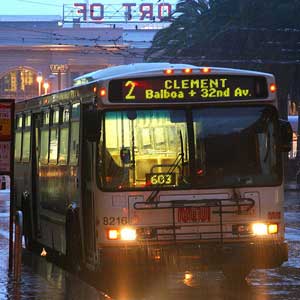 Ensuring transit-only lanes are free of other vehicles is a costly endeavor. Even with just over 15 miles of transit-only lanes in the city of San Francisco, penalizing drivers who obstruct or abuse bus lanes requires too much manpower to make significant enforcement possible. Now, the city has found a more efficient way to cut down on vehicles cluttering up lanes reserved specifically for public transit.
Ensuring transit-only lanes are free of other vehicles is a costly endeavor. Even with just over 15 miles of transit-only lanes in the city of San Francisco, penalizing drivers who obstruct or abuse bus lanes requires too much manpower to make significant enforcement possible. Now, the city has found a more efficient way to cut down on vehicles cluttering up lanes reserved specifically for public transit.
The city of San Francisco is in the process of equipping buses with outward facing cameras so drivers can take pictures of vehicles that are parked illegally or traveling in a transit-only lane. The new Transit Lane Enforcement Law is an extension of a pilot program that’s been in place since 2008. As of now, 30 buses have been outfitted with the enforcement cameras (primarily covering routes in Chinatown and the Financial District) however the city plans to add more cameras in the near future.
Although the policy could be seen as a cash grab for additional revenue from tickets, the need to keep transit lanes clear of other vehicles is a legitimate concern. With San Francisco’s transit system ranking among the slowest in the nation, alleviating unlawful traffic from transit-only lanes could potentially boost on time performance and help raise the fleet’s speed from its current average of just 5 miles per hour on downtown streets.
The reality is that although bus lanes often seem empty, that’s exactly the way they’re supposed to be. An empty transit-only lane allows buses to efficiently make their routes and maintain a reasonable average speed. As SF StreetsBlog points out, in some areas traffic lights are timed in such a way that just one vehicle obstructing the transit-only lane can throw off the entire cycle.
Regardless of what you think about the new initiative, the data collected from the pilot program proves the cameras have been an effective deterrent. One year after the program went into action, bus lane violations had dropped 47 percent and transit lane parking violations decreased by 44 percent. In addition, ccording to an official report, after the first year, cars began “moving as they saw buses approaching to avoid risking a citation.” Now, with the cameras set to become even more widespread, the deterrent should help keep transit-only lanes functioning the way they were intended.
Photo credit: https://www.flickr.com/photos/thomashawk/33326540/



 AI-search
AI-search  Email
Email